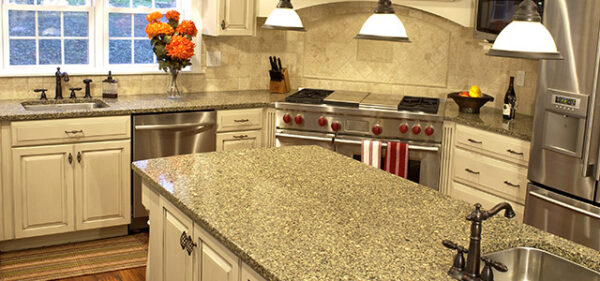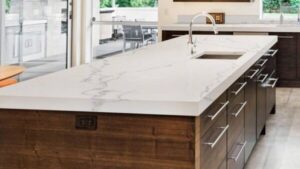Kitchen countertops play an essential role: they should be durable (stain- and heat-proof), beautiful, and affordable – with color playing a key role in meeting these criteria.
Dark surfaces, particularly matte-honed finishes, tend to show dust, marks, and streaks more easily than lighter surfaces.
Determining your objectives and style priorities early can help you set a search strategy and narrow your options.
Material
Caesarstone quartz countertops play an essential role in any kitchen: they serve as a place for food preparation, cooking, and entertaining. Therefore, selecting an attractive yet sturdy material that can withstand heat and stains is vital.
Laminate is one of the most sought-after countertop materials, boasting an array of colors and patterns to fit any style or budget. Additionally, laminate can easily scratch or burn so homeowners must be cautious when handling hot pans and utensils.
Granite countertops are known for their strength and resilience. Not only can they withstand high-heat environments, but their subtle to bold hues offer plenty of visual interest. Though not the easiest material to maintain or clean up after, granite is highly stain-resistant and holds up well against most household cleaning solutions.
Engineered stone quartz is another durable countertop material. This hybrid material combines natural stone with resin to produce a non-porous product resistant to bacteria and viruses, is less expensive than granite, and offers many color choices that mimic its counterpart in nature.
Color
Countertop color plays an integral part in creating the overall appearance of any kitchen, either complementing or clashing with cabinetry and other elements such as tile or wood flooring. Homeowners have many choices available to them when selecting their countertop colors – white, gray, mid-tone and brown are among those offered for consideration.
White Caesarstone quartz countertops provide a crisp, contemporary vibe and complement a range of kitchen styles. Fractured or marbled white granite adds personality to modern spaces, while solid white surfaces can help draw attention away from dark cabinetry.
Dark countertop hues are increasingly popular with homeowners. Deep black shades like London Grey or Pietra Grey pair perfectly with modern kitchens, creating a striking visual impact when combined with black cabinets. Warmer tones such as soft beiges and rich creams work particularly well in homes featuring painted or wood cabinets and can highlight subtle hues in them as well as metallic finishes like brass.
Texture
Countertops that feature rough or smooth textures create an inviting, comfortable ambiance in a kitchen or bathroom, while sleek surfaces such as granite can make the space appear more sophisticated.
Natural stone countertops such as granite are widely acclaimed, but due to their porous nature, they must be sealed periodically for best results. Quartz offers an ideal compromise – less sealing is necessary while still being stain-resistant with numerous colors available to choose from.
Dekton, an engineered material designed to be nearly indestructible, is becoming a more popular option than ever. Available in an array of shades that mimic marble or granite’s look, Dekton doesn’t require special cleaners or sealants to remain heat resistant and requires no special maintenance to remain scratch-proof.
Pattern
Once the big-ticket items such as cabinets and flooring have been set in place, your next step should be selecting your countertop color and pattern. This decision is the most personal of all and will ultimately dictate how the design comes together.
Most designers suggest selecting neutral counter colors if you’re seeking long-term durability, giving more options for design choices as well as forgiving more easily any stains or marks that occur over time.
Patterns depend heavily on the material you choose when it comes to patterns. For instance, stone countertops often feature more veining, flecks, and specks than quartz surfaces; boldly veined stones may stand out immediately but could date more quickly than natural stones with more subdued textures and understated visuals.


















Be First to Comment